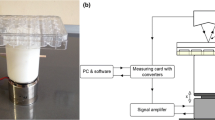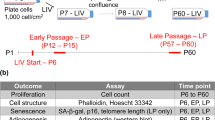Abstract
Bone tissue adapts to its functional environment by optimizing its morphology for mechanical demand. Among the mechanosensitive cells that recognize and respond to forces in the skeleton are osteocytes, osteoblasts, and mesenchymal progenitor cells (MPCs). Therefore, the ability to use mechanical signals to improve bone health through exercise and devices that deliver mechanical signals is an attractive approach to age-related bone loss; however, the extracellular or circulating mediators of such signals are largely unknown. Using SDS-PAGE separation of proteins secreted by MPCs in response to low-magnitude mechanical signals and in-gel trypsin digestion followed by HPLC and mass spectroscopy, we identified secreted proteins up-regulated by vibratory stimulation. We exploited a cell senescence-associated secretory phenotype screen and reasoned that a subset of vibration-induced proteins with diminished secretion by senescent MPCs will have the capacity to promote bone formation in vivo. We identified one such vibration-induced bone-enhancing (vibe) gene as R-spondin 1, a Wnt pathway modulator, and demonstrated that it has the capacity to promote bone formation in three mouse models of age-related bone loss. By virtue of their secretory status, some vibe proteins may be candidates for pre-clinical development as anabolic agents for the treatment of osteoporosis.
Key message
-
Mesenchymal stem cells respond to low magnitude mechanical signals (vibration).
-
R-Spondin 1 is upregulated by mechanical signals and secreted.
-
R-Spondin 1 promotes bone formation in three mouse models of osteoporosis.



Similar content being viewed by others
References
Rubin J, Rubin C, Jacobs CR (2006) Molecular pathways mediating mechanical signaling in bone. Gene 367:1–16
Dalsky GP, Stocke KS, Ehsani AA, Slatopolsky E, Lee WC, Birge SJ Jr (1988) Weight-bearing exercise training and lumbar bone mineral content in postmenopausal women. Ann Intern Med 108:824–828
Smith EL, Gilligan C, McAdam M, Ensign CP, Smith PE (1989) Deterring bone loss by exercise intervention in premenopausal and postmenopausal women. Calcif Tissue Int 44:312–321
Feskanich D, Willett W, Colditz G (2002) Walking and leisure-time activity and risk of hip fracture in postmenopausal women. JAMA 288:2300–2306
Rubin C, Turner AS, Muller R, Mittra E, McLeod K, Lin W, Qin YX (2002) Quantity and quality of trabecular bone in the femur are enhanced by a strongly anabolic, noninvasive mechanical intervention. J Bone Miner Res 17:349–357
Ward K, Alsop C, Caulton J, Rubin C, Adams J, Mughal Z (2004) Low magnitude mechanical loading is osteogenic in children with disabling conditions. J Bone Miner Res 19:360–369
Gilsanz V, Wren TA, Sanchez M, Dorey F, Judex S, Rubin C (2006) Low-level, high-frequency mechanical signals enhance musculoskeletal development of young women with low BMD. J Bone Miner Res 21:1464–1474
Bass SL, Saxon L, Daly RM, Turner CH, Robling AG, Seeman E, Stuckey S (2002) The effect of mechanical loading on the size and shape of bone in pre-, peri-, and postpubertal girls: a study in tennis players. J Bone Miner Res 17:2274–2280
Ducher G, Tournaire N, Meddahi-Pelle A, Benhamou CL, Courteix D (2006) Short-term and long-term site-specific effects of tennis playing on trabecular and cortical bone at the distal radius. J Bone Miner Metab 24:484–490
Warden SJ (2006) Breaking the rules for bone adaptation to mechanical loading. J Appl Physiol 100:1441–1442
Luu YK, Capilla E, Rosen CJ, Gilsanz V, Pessin JE, Judex S, Rubin CT (2009) Mechanical stimulation of mesenchymal stem cell proliferation and differentiation promotes osteogenesis while preventing dietary-induced obesity. J Bone Miner Res 24:50–61
D’Ippolito G, Schiller PC, Ricordi C, Roos BA, Howard GA (1999) Age-related osteogenic potential of mesenchymal stromal stem cells from human vertebral bone marrow. J Bone Miner Res 14:1115–1122
Zhou S, Greenberger JS, Epperly MW, Goff JP, Adler C, Leboff MS, Glowacki J (2008) Age-related intrinsic changes in human bone-marrow-derived mesenchymal stem cells and their differentiation to osteoblasts. Aging Cell 7:335–343
Du X, Shen J, Kugan N, Furth EE, Lombard DB, Cheung C, Pak S, Luo G, Pignolo RJ, DePinho RA et al (2004) Telomere shortening exposes functions for the mouse Werner and Bloom syndrome genes. Mol Cell Biol 24:8437–8446
Pignolo RJ, Suda RK, McMillan EA, Shen J, Lee SH, Choi Y, Wright AC, Johnson FB (2008) Defects in telomere maintenance molecules impair osteoblast differentiation and promote osteoporosis. Aging Cell 7:23–31
Wang H, Chen Q, Lee SH, Choi Y, Johnson FB, Pignolo RJ (2012) Impairment of osteoblast differentiation due to proliferation-independent telomere dysfunction in mouse models of accelerated aging. Aging Cell 11(4):704–713
Cristofalo VJ, Charpentier R (1980) A standard procedure for cultivating human diploid fibroblastlike cells to study cellular aging. J Tissue Cult Methods 6:117–121
Fritton JC, Rubin CT, Qin YX, McLeod KJ (1997) Whole-body vibration in the skeleton: development of a resonance-based testing device. Ann Biomed Eng 25:831–839
Wei Q, Yokota C, Semenov MV, Doble B, Woodgett J, He X (2007) R-spondin1 is a high affinity ligand for LRP6 and induces LRP6 phosphorylation and beta-catenin signaling. J Biol Chem 282:15903–15911
Egan KP, Brennan TA, Pignolo RJ (2012) Bone histomorphometry using free and commonly available software. Histopathology 61:1168–1173
Dempster DW, Compston JE, Drezner MK, Glorieux FH, Kanis JA, Malluche H, Meunier PJ, Ott SM, Recker RR, Parfitt AM (2013) Standardized nomenclature, symbols, and units for bone histomorphometry: a 2012 update of the report of the ASBMR Histomorphometry Nomenclature Committee. J Bone Miner Res 28:2–17
Kronke G, Uderhardt S, Kim KA, Stock M, Scholtysek C, Zaiss MM, Surmann-Schmitt C, Luther J, Katzenbeisser J, David JP et al (2010) R-spondin 1 protects against inflammatory bone damage during murine arthritis by modulating the Wnt pathway. Arthritis Rheum 62:2303–2312
Hankenson KD, Sweetwyne MT, Shitaye H, Posey KL (2010) Thrombospondins and novel TSR-containing proteins, R-spondins, regulate bone formation and remodeling. Curr Osteoporos Rep 8:68–76
Robling AG, Turner CH (2009) Mechanical signaling for bone modeling and remodeling. Crit Rev Eukaryot Gene Expr 19:319–338
Fritton JC, Myers ER, Wright TM, van der Meulen MC (2005) Loading induces site-specific increases in mineral content assessed by microcomputed tomography of the mouse tibia. Bone 36:1030–1038
Eser P, Frotzler A, Zehnder Y, Wick L, Knecht H, Denoth J, Schiessl H (2004) Relationship between the duration of paralysis and bone structure: a pQCT study of spinal cord injured individuals. Bone 34:869–880
Huiskes R, Ruimerman R, van Lenthe GH, Janssen JD (2000) Effects of mechanical forces on maintenance and adaptation of form in trabecular bone. Nature 405:704–706
Bonewald LF (2011) The amazing osteocyte. J Bone Miner Res 26:229–238
Slatkovska L, Alibhai SM, Beyene J, Hu H, Demaras A, Cheung AM (2011) Effect of 12 months of whole-body vibration therapy on bone density and structure in postmenopausal women: a randomized trial. Ann Intern Med 155(668–679):W205
Kiiski J, Heinonen A, Jarvinen TL, Kannus P, Sievanen H (2008) Transmission of vertical whole body vibration to the human body. J Bone Miner Res 23:1318–1325
Birchmeier W (2011) Stem cells: orphan receptors find a home. Nature 476:287–288
Carmon KS, Gong X, Lin Q, Thomas A, Liu Q (2011) R-spondins function as ligands of the orphan receptors LGR4 and LGR5 to regulate Wnt/beta-catenin signaling. Proc Natl Acad Sci U S A 108:11452–11457
de Lau W, Barker N, Low TY, Koo BK, Li VS, Teunissen H, Kujala P, Haegebarth A, Peters PJ, van de Wetering M et al (2011) Lgr5 homologues associate with Wnt receptors and mediate R-spondin signalling. Nature 476:293–297
Glinka A, Dolde C, Kirsch N, Huang YL, Kazanskaya O, Ingelfinger D, Boutros M, Cruciat CM, Niehrs C (2011) LGR4 and LGR5 are R-spondin receptors mediating Wnt/beta-catenin and Wnt/PCP signalling. EMBO Rep 12:1055–1061
Wagner ER, Zhu G, Zhang BQ, Luo Q, Shi Q, Huang E, Gao Y, Gao JL, Kim SH, Rastegar F et al (2011) The therapeutic potential of the Wnt signaling pathway in bone disorders. Curr Mol Pharmacol 4:14–25
Park JI, Venteicher AS, Hong JY, Choi J, Jun S, Shkreli M, Chang W, Meng Z, Cheung P, Ji H et al (2009) Telomerase modulates Wnt signalling by association with target gene chromatin. Nature 460:66–72
Hoffmeyer K, Raggioli A, Rudloff S, Anton R, Hierholzer A, Del Valle I, Hein K, Vogt R, Kemler R (2012) Wnt/beta-catenin signaling regulates telomerase in stem cells and cancer cells. Science 336:1549–1554
Barker N, Hurlstone A, Musisi H, Miles A, Bienz M, Clevers H (2001) The chromatin remodelling factor Brg-1 interacts with beta-catenin to promote target gene activation. EMBO J 20:4935–4943
Beck S, Jin X, Sohn YW, Kim JK, Kim SH, Yin J, Pian X, Kim SC, Nam DH, Choi YJ et al (2011) Telomerase activity-independent function of TERT allows glioma cells to attain cancer stem cell characteristics by inducing EGFR expression. Mol Cells 31:9–15
Choi J, Southworth LK, Sarin KY, Venteicher AS, Ma W, Chang W, Cheung P, Jun S, Artandi MK, Shah N et al (2008) TERT promotes epithelial proliferation through transcriptional control of a Myc- and Wnt-related developmental program. PLoS Genet 4:e10
Zhang Y, Toh L, Lau P, Wang X (2012) Human telomerase reverse transcriptase (hTERT) is a novel target of the Wnt/beta-catenin pathway in human cancer. J Biol Chem 287:32494–32511
Campisi J, d’Adda di Fagagna F (2007) Cellular senescence: when bad things happen to good cells. Nat Rev Mol Cell Biol 8:729–740
Krtolica A, Parrinello S, Lockett S, Desprez PY, Campisi J (2001) Senescent fibroblasts promote epithelial cell growth and tumorigenesis: a link between cancer and aging. Proc Natl Acad Sci U S A 98:12072–12077
Parrinello S, Coppe JP, Krtolica A, Campisi J (2005) Stromal-epithelial interactions in aging and cancer: senescent fibroblasts alter epithelial cell differentiation. J Cell Sci 118:485–496
Acknowledgments
This work was supported by National Institutes of Health/ National Institute on Aging grants R01AG028873 (R.J.P) and P01AG031862 (D.C.S., F.B.J.). The Juvent 1000 Dynamic Motion Platform was a generous gift from Mary Leonard, MD, MSCE (Children’s Hospital of Philadelphia, Philadelphia, Pennsylvania).
Disclosure statement
The authors declare no conflicts of interest related to the work presented in this paper.
Author information
Authors and Affiliations
Corresponding author
Rights and permissions
About this article
Cite this article
Wang, H., Brennan, T.A., Russell, E. et al. R-spondin 1 promotes vibration-induced bone formation in mouse models of osteoporosis. J Mol Med 91, 1421–1429 (2013). https://doi.org/10.1007/s00109-013-1068-3
Received:
Revised:
Accepted:
Published:
Issue Date:
DOI: https://doi.org/10.1007/s00109-013-1068-3




